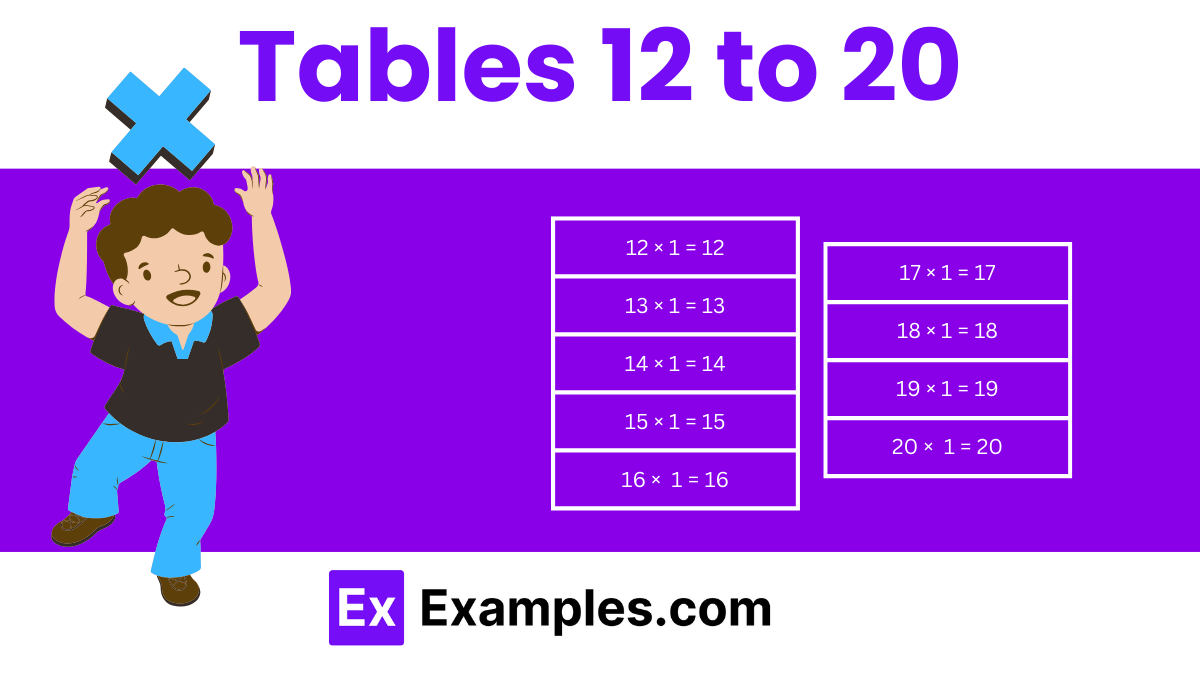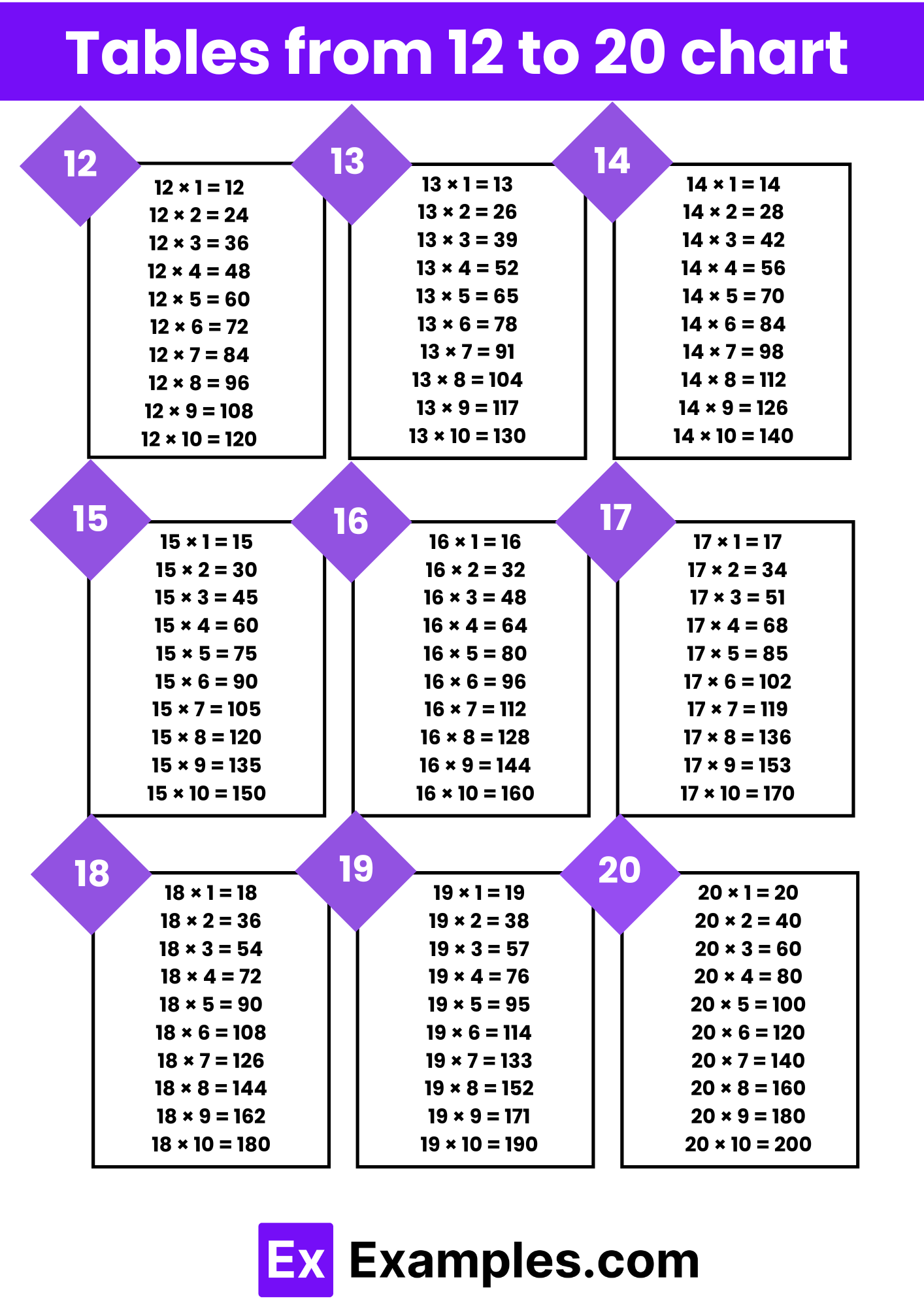What number should be multiplied with 15 to get 225?
13
14
15
16


The multiplication tables from 12 to 20 extend beyond the basic framework often emphasized in early schooling, challenging students to deepen their arithmetic skills. These tables are essential for more complex mathematical tasks such as advanced multiplication, division, and introductory algebra. Mastering these tables enhances computational fluency, allowing students to handle larger numbers and more intricate calculations with confidence. This range of tables is particularly beneficial in applications involving measurements, financial calculations, and engineering contexts where higher multiples frequently occur.

Download Tables from 12 to 20 Pdf
A multiplication chart covering tables from 12 to 20 presents a matrix-like format where the rows and columns labeled 12 through 20 intersect to reveal their products. This specific range in a multiplication chart is crucial for advanced arithmetic learning, helping to visualize and reinforce the relationships between higher numbers, enhancing mathematical fluency and understanding of algebraic principles.
A multiplication chart for tables from 12 to 20 simplifies learning higher multiplication tables by visually presenting the products of numbers in this range. Each row in the chart corresponds to one of the base numbers (from 12 to 20), and each column represents the numbers 1 through 10 (or 12 to 20, depending on preference). The intersection of a row and a column gives the product of the two numbers, facilitating quick reference and study. This chart is especially useful for students advancing in mathematics, helping them quickly master the multiplication of larger numbers through a simple and straightforward format.
Download Tables from 12 to 20 Pdf
| 12 x 1 = 12 | 13 x 1 = 13 | 14 x 1 = 14 | 15 x 1 = 15 | 16 x 1 = 16 |
|---|---|---|---|---|
| 12 x 2 = 24 | 13 x 2 = 26 | 14 x 2 = 28 | 15 x 2 = 30 | 16 x 2 = 32 |
| 12 x 3 = 36 | 13 x 3 = 39 | 14 x 3 = 42 | 15 x 3 = 45 | 16 x 3 = 48 |
| 12 x 4 = 48 | 13 x 4 = 52 | 14 x 4 = 56 | 15 x 4 = 60 | 16 x 4 = 64 |
| 12 x 5 = 60 | 13 x 5 = 65 | 14 x 5 = 70 | 15 x 5 = 75 | 16 x 5 = 80 |
| 12 x 6 = 72 | 13 x 6 = 78 | 14 x 6 = 84 | 15 x 6 = 90 | 16 x 6 = 96 |
| 12 x 7 = 84 | 13 x 7 = 91 | 14 x 7 = 98 | 15 x 7 = 105 | 16 x 7 = 112 |
| 12 x 8 = 96 | 13 x 8 = 104 | 14 x 8 = 112 | 15 x 8 = 120 | 16 x 8 = 128 |
| 12 x 9 = 108 | 13 x 9 = 117 | 14 x 9 = 126 | 15 x 9 = 135 | 16 x 9 = 144 |
| 12 x 10 = 120 | 13 x 10 = 130 | 14 x 10 = 140 | 15 x 10 = 150 | 16 x 10 = 160 |
| 17 x 1 = 17 | 18 x 1 = 18 | 19 x 1 = 19 | 20 x 1 = 20 |
| 17 x 2 = 34 | 18 x 2 = 36 | 19 x 2 = 38 | 20 x 2 = 40 |
| 17 x 3 = 51 | 18 x 3 = 54 | 19 x 3 = 57 | 20 x 3 = 60 |
| 17 x 4 = 68 | 18 x 4 = 72 | 19 x 4 = 76 | 20 x 4 = 80 |
| 17 x 5 = 85 | 18 x 5 = 90 | 19 x 5 = 95 | 20 x 5 = 100 |
| 17 x 6 = 102 | 18 x 6 = 108 | 19 x 6 = 114 | 20 x 6 = 120 |
| 17 x 7 = 119 | 18 x 7 = 126 | 19 x 7 = 133 | 20 x 7 = 140 |
| 17 x 8 = 136 | 18 x 8 = 144 | 19 x 8 = 152 | 20 x 8 = 160 |
| 17 x 9 = 153 | 18 x 9 = 162 | 19 x 9 = 171 | 20 x 9 = 180 |
| 17 x 10 = 170 | 18 x 10 = 180 | 19 x 10 = 190 | 20 x 10 = 200 |
Problem:
12 x 8 = ?
Solution:
12 x 8 = 96
(Twelve times eight results in ninety-six.)
Problem:
13 x 6 = ?
Solution:
13 x 6 = 78
(Thirteen multiplied by six yields seventy-eight.)
Problem:
14 x 9 = ?
Solution:
14 x 9 = 126
(Fourteen times nine equals one hundred twenty-six.)
Problem:
15 x 7 = ?
Solution:
15 x 7 = 105
(Fifteen multiplied by seven results in one hundred five.)
Problem:
16 x 5 = ?
Solution:
16 x 5 = 80
(Sixteen times five equals eighty.)
Problem:
17 x 3 = ?
Solution:
17 x 3 = 51
(Seventeen times three yields fifty-one.)
Problem:
18 x 4 = ?
Solution:
18 x 4 = 72
(Eighteen multiplied by four results in seventy-two.)
Problem:
19 x 8 = ?
Solution:
19 x 8 = 152
(Nineteen times eight equals one hundred fifty-two.)
Problem:
20 x 10 = ?
Solution:
20 x 10 = 200
(Twenty times ten results in two hundred.)
Problem:
12 x 10 = ?
Solution:
12 x 10 = 120
(Twelve times ten equals one hundred twenty.)
Knowing multiplication tables 12 to 20 is useful in various everyday situations such as calculating prices at the store, determining quantities for recipes or DIY projects, and managing finances. Additionally, it helps in making quick mental calculations and solving real-world problems efficiently.
Yes, there are numerous online tools and websites available that offer interactive games, quizzes, tutorials, and printable worksheets specifically designed for learning multiplication tables 12 to 20.
There are many resources available, including books, worksheets, online games, educational apps, and videos. Additionally, many schools offer specialized programs or interventions to support students in learning multiplication tables 12 to 20.
The age at which children are expected to know their multiplication tables up to 20 can vary, but most students typically begin learning them in elementary school, around the ages of 7 to 9. Mastery of multiplication tables up to 20 is usually expected by the end of elementary school.
Mastering multiplication tables 12 to 20 leads to increased speed and accuracy in mathematical calculations, improves problem-solving skills, and lays a strong foundation for learning more advanced math concepts in the future.
Text prompt
Add Tone
10 Examples of Public speaking
20 Examples of Gas lighting
What number should be multiplied with 15 to get 225?
13
14
15
16
If 16 is multiplied by which number, the result is 256?
15
16
17
18
Which of the following is not a multiple of 18?
54
72
90
98
What is the missing number: 19 × _ = 342?
16
17
18
19
If 20 times a number equals 400, what is the number?
18
19
20
21
What is the product of 17 and the sum of 2 and 3?
75
85
95
105
How many times does 14 fit into 196?
12
13
14
15
If 18 times a number equals 252, what is the number?
12
13
14
15
What is the missing number: 16×_=320?
19
20
21
22
If 15 is multiplied by which number, the result is 195?
12
13
14
15
Before you leave, take our quick quiz to enhance your learning!

